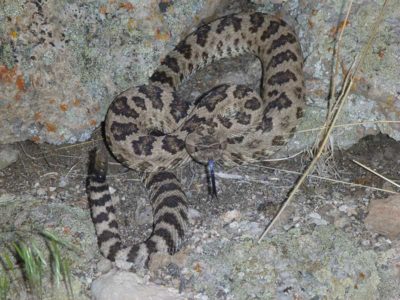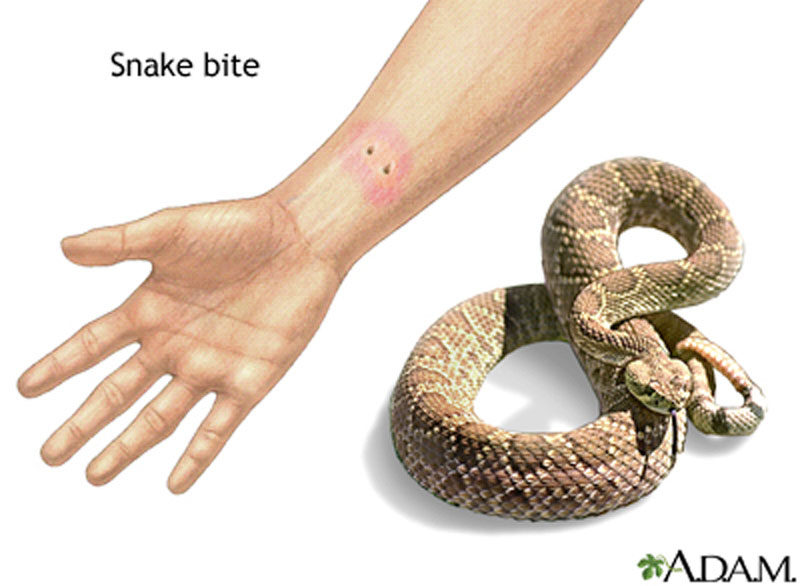(Updated on April 3, 2025, for grammar only / Author: Tim Bondy) This “Snake Bite … What to do guide” while on the trail in southern Idaho seemed like a sensible guide to research, understand and have with me when mountain biking, hiking, rockhounding, and fishing in the backcountry. For me, on average, true medical help will likely be at least 2 hours away and in some cases 4+ hours away. This guide was created by Tim Bondy, for Tim Bondy, but if it helps you, then all the better.
What To Do After a Snake Bite … if Alone – Experts Opinion
- You just got bit
- Try to remain calm / don’t panic
- Realize, only in rare instances do people die from rattlesnake bites
- If possible, try to get a quick photo of the snake that bit you
- Regular rattlesnake anti-venom is effective on all western U.S. rattlesnakes
- Note the time you got bit
- Sit down and figure out a game plan on how to get back to your vehicle
Expect the Following
- Moderate to severe burning pain at the bite site within 15 to 30 minutes
- Within 20-45 minutes, swelling and bruising at the wound, and all the way up the arm or leg
- Nausea and vomiting
- Labored breathing
- Disturbed vision
- Increased salivation and sweating
- Numbness or tingling around your face and/or limbs
- A general sense of weakness
- An odd taste in the mouth
Take Action
- Make sure the clothing/jewelry above and below the bite area is very loose
- The bite area will probably swell a lot
- Cover it with a clean, dry dressing
- Review your maps
- Don’t panic – try to keep your heart rate down
- Realize, only in rare instances do people die from rattlesnake bites
- Head back to your vehicle
- Don’t get lost or take unknown shortcuts
- Occasionally check to see if you have cell coverage
- ** Text or call 9.1.1. and let them know the facts **
- Get to the hospital ASAP
- ** When texting, as opposed to calling 9-1-1 because of low signal strength (mountains and distance), emergency personnel will have a hard time determining your location from that text. Knowing where you are and keeping the handset on for a reverse “ping” may be a life saving action. **
Do not:
- Do Not … Try to suck the snake venom out of the wound.
- Do Not … Flush the bite area with water
- Do Not … Ice the bite
- Do Not … Tourniquet the bite
- Do Not … Mess with the bite

Type of Venomous Snake I Will Encounter
There is some disagreement among experts about the name and subspecies of Western Rattlesnakes that live in southern Idaho. In the grand scheme of life, the name or subspecies probably doesn’t matter too much. The important thing to know is “was it a western rattlesnake that bit you” or was it some other type of snake.
From the research I did, it appears that it doesn’t matter which type of rattlesnake bit you when it comes to administering anti-venom. The serum is the same for all rattlesnakes in the Western U.S. I only suggest you get a photo of the snake that bit you as a way to confirm it was a venomous snake and not the bite of a painful yet non-venomous bull snake.
Venomous Snake Present in Idaho and my Adventure Area
- Northern Pacific Rattlesnake [Crotalus oreganus]
- Great Basin Rattlesnake [Crotalus lutosus lotosus]
- Prairie Rattlesnake [Crotalus viridis viridis]
The Western Rattlesnake includes the Prairie Rattlesnake, the Great Basin Rattlesnake and the Northern Pacific Rattlesnake [Crother et al. 2012], have the most extensive distribution of any venomous reptile in North America, ranging from southern Canada to northern Mexico and from the Pacific Coast to the mid-western United States.
Rattlesnake Habitat/Behavior
- Rattlesnakes tend to hunt at dusk when they begin to move and look for a good spot to ambush a mouse, rat, ground squirrel or rabbit.
- The Rattlesnake lies in wait until its prey comes along. Even in total darkness, its prey will be visible to the snake.
- It may be accurate to say the rattlesnake can see a heat image of its prey, and it can strike in darkness if the prey is even slightly warmer than its background.
- The rattlesnakes fangs inject venom into its prey. The species and habitat of the rattlesnake determines how potent its venom is.
- Rattlesnakes feed on rodents and other small animals, subduing them with a venomous bite as opposed to constricting.
- Rattlesnakes are especially known to strike at distances up to two-thirds their body length.
- Rattlesnakes are rather drab, like other species. They tend to camouflage themselves with their surroundings, and are therefore black, brown, olive, gray or tan, with diamond or band patterns on them.
- The elliptical pupils of a rattlesnake helps it to see objects as far as 40 feet away, at night.
- They usually prefer a temperature of 80° F to 90° F, although they can survive in freezing temperatures as well. Very high temperatures can be fatal for them.
- It won’t be wrong to say that rattlesnakes are mostly nocturnal creatures. In the summers, adult rattlers are mostly seen hunting for prey at night.
- The babies have venom from birth, so don’t get fooled by their size. In fact, baby snakes are more dangerous, as they strike repeatedly and their venom is as poisonous as the adults.
- In the U.S. approximately 8,000 people get bit by venomous snakes every year. Less than 10, on average, are fatal.
- 25% of the rattlesnake bites are dry bites, where no venom is released.
Reference for graphics and information presented in this guide came from: https://animalsake.com/rattlesnake-facts / https://m.ufhealth.org/snake-bites / https://www.cdc.gov/niosh/topics/snakes/symptoms.html / https://healthcare.utah.edu/the-scope/shows.php?shows=0_vookb28x
Originally published on April 14, 2019
Thanks,
~ signed ~
Tim Bondy
Freelance Writer & Citizen Journalist
“Life is 10% what happens to you and 90% how you react to it.” ~ Charles R. Swindoll

